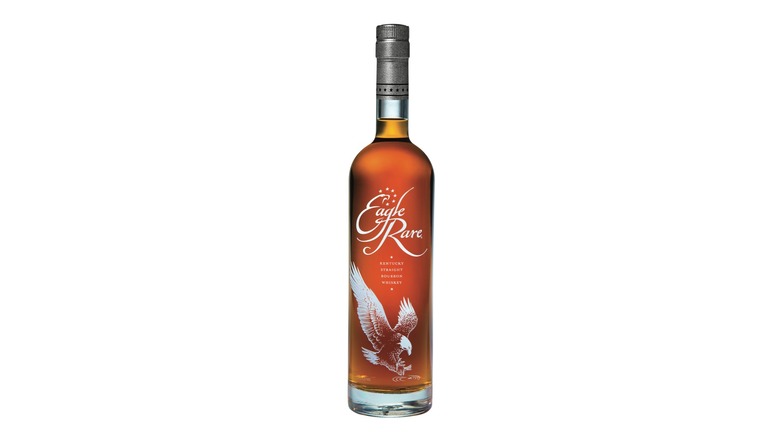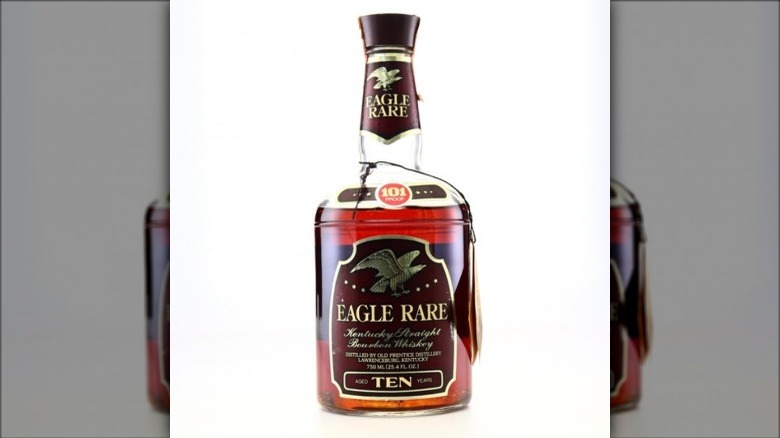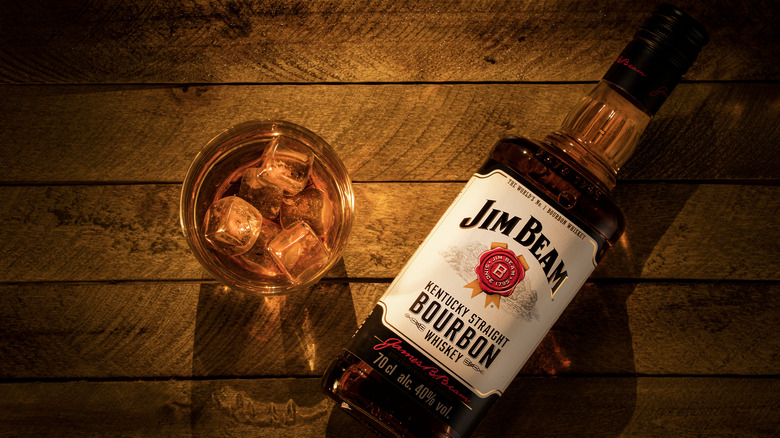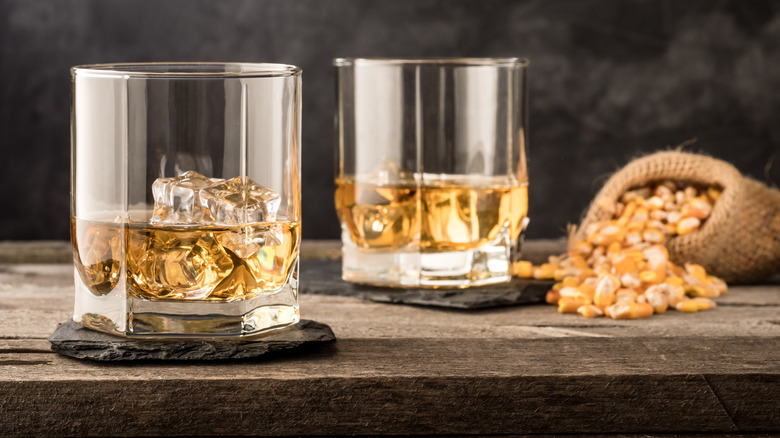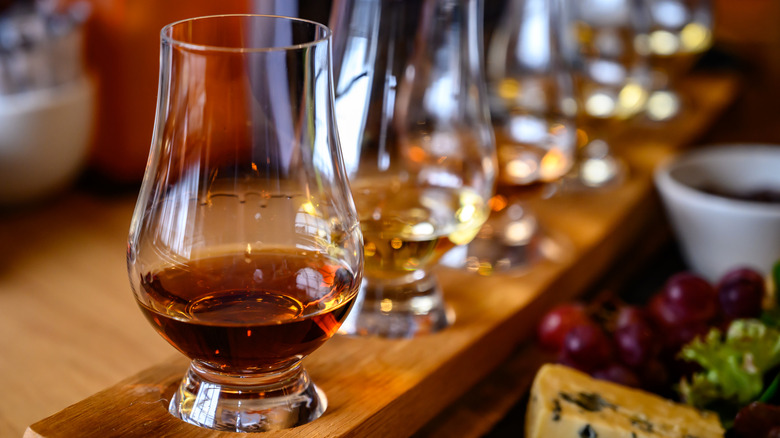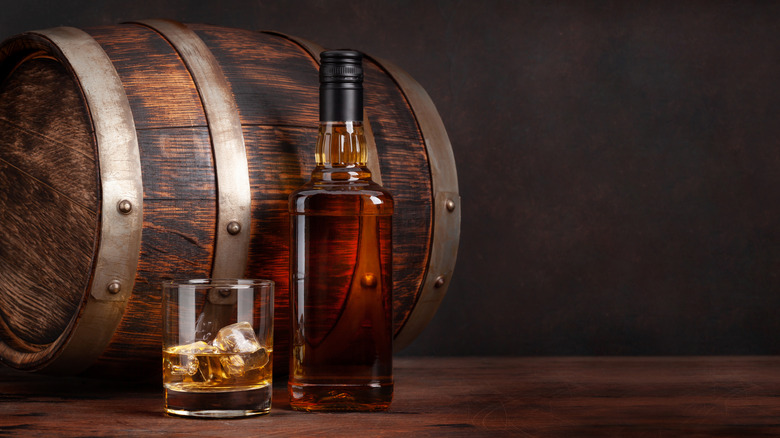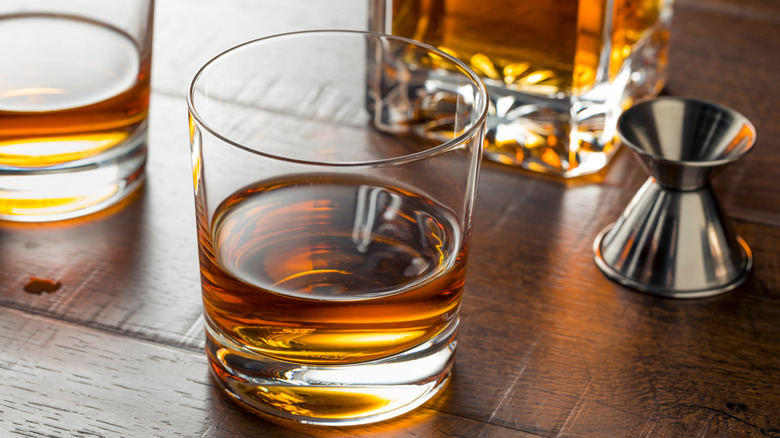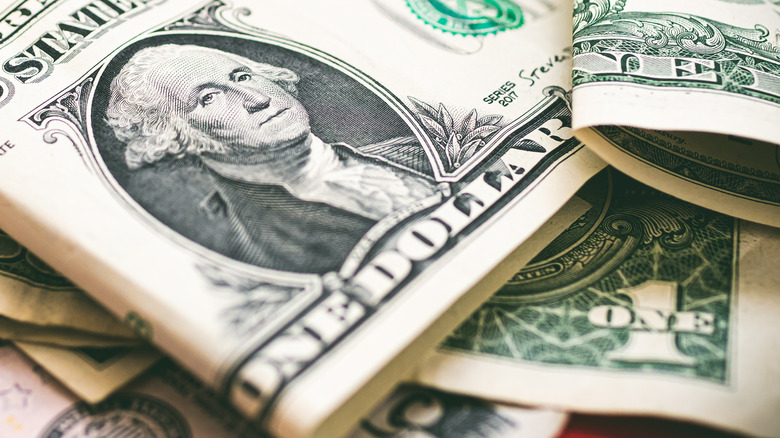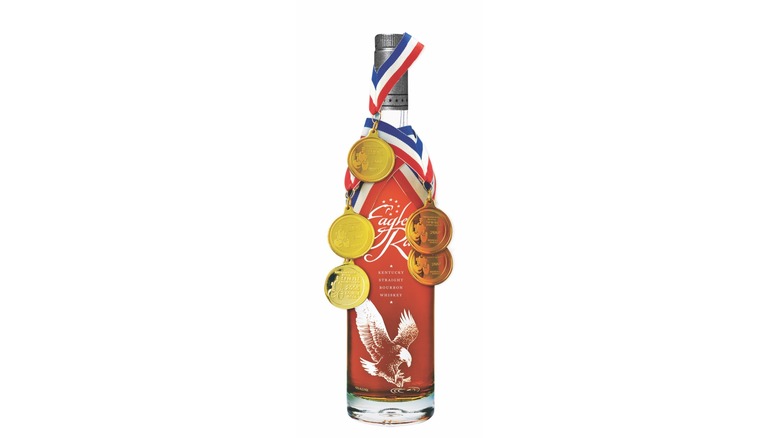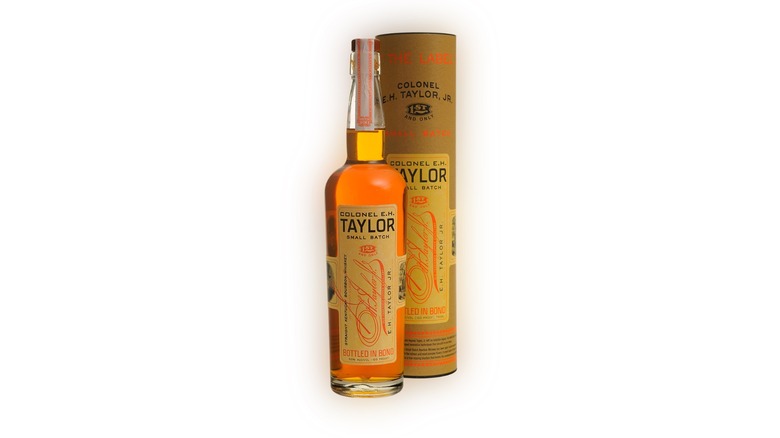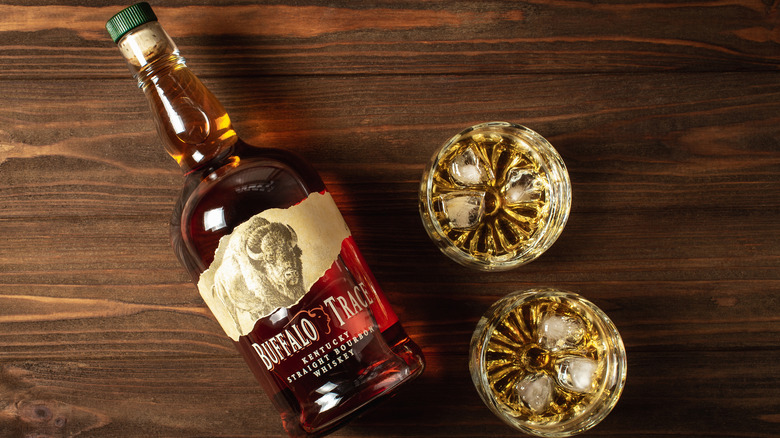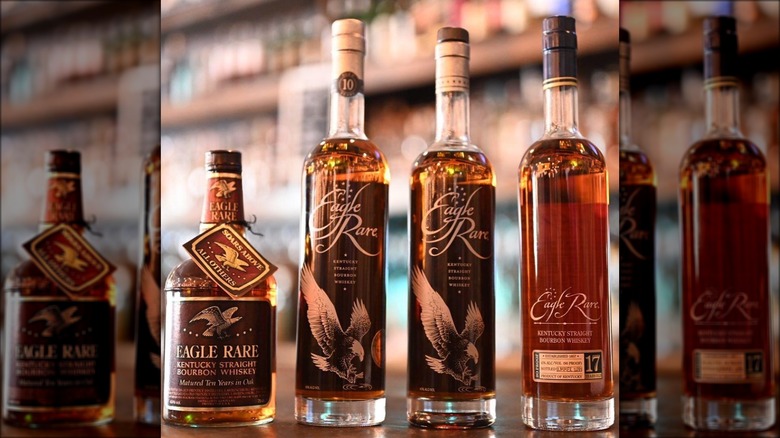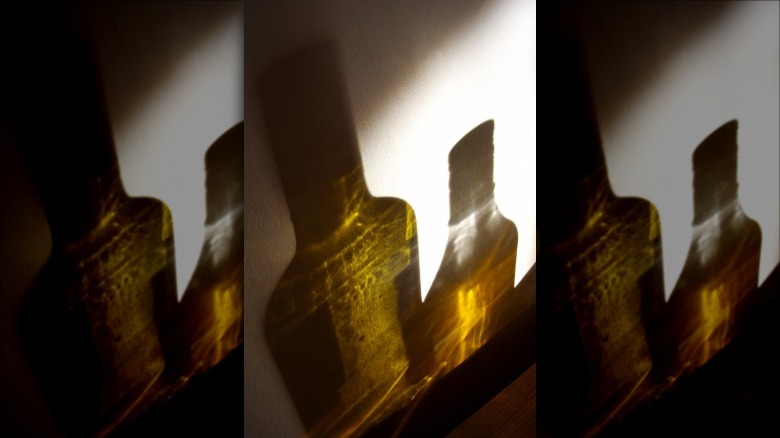Eagle Rare 10 Year Bourbon: Everything You Need To Know
According to Talks on Law, bourbon is legally defined as a drink made from at least 51 percent corn mash and aged in new oak barrels. While one might think that bourbons coming from the same facilities would taste the same, make no mistake. Bottles like Eagle Rare are distinct from the competition.
The ingredients, for one, can change the taste. While 51 percent of a mash must be corn to legally make it a bourbon, the other 49 percent can be any other grain. Buffalo Trace uses two main mash bills for their bourbons. While brands such as Blanton's use a more rye-forward mash bill #2, as per Bourbonr, bottles from Eagle Rare use the lower rye mash bill #1, which allows the natural sweetness of the corn to show through.
The aging process can also affect the taste of a bourbon. Variables such as time, finishing barrels, and even the location within a warehouse can make or break the difference in the flavor of bourbon. For example, Eagle Rare 10-year is aged for at least a decade (hence the name), resulting in a somewhat smooth taste and a perfectly respectable 90-proof alcohol content. Here's everything else you need to know about Eagle Rare 10 Year Bourbon.
Eagle Rare debuted amid an industry downturn
Eagle Rare has not always been its reasonable 90-proof recipe.Yet, when the bourbon debuted, it pushed the limits of what can legally be called bourbon and was much more alcoholic.
According to Gentleman Ranters, whiskey consumption went seriously downhill in the 1960s and 1970s. Production was still at its usual level, but fewer people were buying whiskey. At the time, Charles Beam, the master distiller at Seagram's, saw the ominous trend and recognized that the decrease in the output was actually a hidden opportunity. This downturn meant that the company could increase its ability to put out more prized (and pricier) aged products. So in 1975, Seagram launched Eagle Rare 10-year as a 101-proof whiskey.
If you are a bourbon fan and notice some similarities between this and another avian-themed whiskey, that is no coincidence. Eagle Rare created its 101-proof selection to be an homage to (or, some might say, a director competitor of) the equally potent and often beginner-friendly Wild Turkey (via Gentleman Ranters). To kick it up a notch and stand out amongst the competition, Eagle Rare added an age statement of 10 years to its bottle.
Eagle Rare was created by the nephew of Jim Beam
According to Gentleman Ranters, master distiller Charles Beam created the original 101-proof iteration of the Eagle Rare brand. If the last name sounds familiar, that is because Charles Beam was a part of the famous bourbon Beam family. As per Whiskey University, the legacy started in 1785 when Jacob Beam moved next door to a group of Catholics, including Basil Hayden, who taught Beam how to distill. His products became increasingly popular, and a legacy was born.
James "Jim" Beam and Joe Beam were the grandsons of Jacob Beam. Jim in particular continued his grandfather's legacy and founded James Beam Bourbon. Meanwhile, Charles Beam was born to Roy Beam, Joe's son. So, Charles Beam is both great-great-grandson of Jacob Beam and the grand-nephew of Jim Beam himself.
Turns out those are just a few of the many Beam family members involved in the bourbon business, according to Bourbon Fool. For instance, Charles Beam's son David went on to work at the family distillery. Jim's grandson, Carl, went on to become a master distiller at the James B. Beam Distillery. What's more, Carl's son Edward Beam also became a master distiller. Talk about a family business!
The recipe has changed over time
The alcohol content of Eagle Rare is not the only thing that's changed over time. When it comes to whiskey, it is not always the physical ingredients that make the difference in taste. The process itself can dramatically affect the final product, as is the case for Eagle Rare.
It all began with the company changing hands. In 1989 the Sazarac company purchased seven brands, including Eagle Rare, from Seagram's. Significantly, in 1992 Sazarac also acquired Buffalo Trace Distillery.
According to Gentleman Ranters, in 2005, the brand discontinued the 101-proof version of Eagle Rare whiskey in favor of the 90-proof version we know today. In 2012, after the brand took on a series of significant updates to the facilities, the ten-year age statement was removed from the name. What's more, the single barrel signifier was removed from the bottle entirely. The new bottle processing equipment meant it was now possible to continue to fill a bottle by moving onto a new barrel mid-fill, increasing efficiency but also potentially melding the unique flavors of individual barrels within one bottle. Furthermore, modifying the labels was an effort to avoid trouble with the U.S. Tobacco and Alcohol Tax and Trade Bureau.
What does Eagle Rare 10-year taste like?
One of the advantages of the many changes Eagle Rare has undergone is that, arguably, consumers ended up with a better and more drinkable whiskey. Strong 101-proof bourbons can be quite cutting due to the high alcohol content, for one. Meanwhile, as The Whiskey Wash notes, multi-barrel blended bourbons tend to rely on the mixing process to mellow out unappealing or harsh flavors that can turn off some consumers. While Eagle Rare is no longer technically a single barrel, it is, at most, a two barrel blend. This means it still must rely on a smoother and better ferment for the product.
As Eagle Rare is not a rye-heavy whiskey, it is not as spicy as those whiskey varieties. What it lacks in that sort of flavor is made up in the complexity of the final product. According to the Eagle Rare website, the 10- year bourbon is bold and dry with a lingering taste. It has a nose of toffee, orange peel, herbs, honey, leather, and oak. The taste is oaky, enhanced with candied nuts and cocoa. Whiskey reviewer The Whiskey Wash agrees with these flavor notes and notes the bourbon's smooth and rich flavor.
How Eagle Rare is made
When it comes to making whiskey, everything starts with the ingredients. When it comes to the building blocks of bourbon, It is no accident that Kentucky became the bourbon capital of the United States. According to Farm Flavor, Kentucky's agriculture facilitated the growth of quality grains such as the corn, rye, and barley used to make Eagle Rare. Additionally, Buffalo Trace Distillery's location was chosen because of the proximity to the Kentucky River, which provides the distillery with limestone-filtered water the company uses to create some of its whiskeys.
The ingredients are used to make the mash and then set to ferment. Eagle Rare is aged for at least 10 years in American oak barrels. After this aging process, the whiskeys are then filtered to pull out the debris from the barrel and leave the drinker with a clean, more palatable spirit. When it comes time to filter out the impurities, Eagle Rare utilizes a chill filter process (via Whisky Resource). In a chill filter process, as Whisky Advocate reports, the whiskey is cooled and then run through a filter system. This process removes chemical impurities that can cause the whiskey to be cloudy, leaving you with a clearer bourbon in the bottle.
How to drink Eagle Rare
We are not in the business of telling people how to drink whiskey, but we would be remiss if we did not encourage proper drinking etiquette regarding a fine whiskey. Eagle Rare may not be top shelf, but it does not sit at the bottom either. It comes at a not-insignificant price, and with the bourbon's smooth flavor is not necessarily the whiskey you want to dilute or muddle with a mixer in a cocktail.
Liquor.com recommends that you enjoy Eagle Rare straight or perhaps simply on the rocks with some ice. Those who need a more mellow experience may also find that this bourbon, like so many other whiskys, is more drinkable mixed with water to help open up the bourbon and dilute its harsher qualities.
According to The Whiskey Shelf, Eagle Rare's website once stated the whiskey could be served neat or over ice. They also wrote that Eagle Rare could be used in bourbon-based cocktails such as a Manhattan or whiskey sour. It should be noted, though, that the company's page no longer makes drinking suggestions, and we suspect they will be happy with however you choose to enjoy their product.
Eagle Rare is relatively affordable
Understanding the price point of Eagle Rare can get a smidge convoluted. As with many of the Buffalo Trace brands, Eagle Rare can be hard to find outside of the distillery, and therefore when it is for sale, it may end up selling for well over the company's suggested sale price.
According to Gentleman Ranters, Eagle Rare's manufacturer's suggested retail price (MSRP) is set at about $30. This puts it roughly in the range of a standard, or mid-shelf, bourbon. However, as noted, the MSRP is not the actual price you might pay for this bourbon. At liquor marketplace Drizly, a bottle of Eagle Rare will cost nearly $90 — and that's before shipping.
You may wonder, then, if Eagle Rare is really worth the hit on your wallet. Indeed, you could purchase a bottle of very nice whiskey for its actual selling price. So is Eagle Rare worth it? Only you can judge, though fans will certainly argue in its favor. You may, however, want to keep an eye out for it at a local store unless you can take the cost of shipping.
Why Eagle Rare is so hard to find
At the price point often seen for a bottle of Eagle Rare, it is clear that there is a greater demand for the bourbon than there is supply. That is, finding bottles of this stuff can be difficult even for the most dedicated of searchers. But why is that?
For one, as Gear Patrol notes, Eagle Rare has been designed to create a supply-demand market in its favor by only releasing a limited number of its product to distributors at any given time. This is not new or even unique to Eagle Rare, though. There is a whole market for what are called "allocated" bourbons that use the same tactic to boost demand (via Wine Enthusiast).
We should note that this is not a ploy on Eagle Rare's side to make you pay more than you should for its bourbon. The company, remember, has not actually raised the price and has stated they did not intend to do so, as per Gentleman Ranters. However, by distributing Eagle Rare as an allocated liquor, the distributors know they can charge super-premium fees for bottles of Eagle Rare. Ramping up production would be one way of fixing this, but we doubt the company will do that as they do not want to reduce the quality of their fine bourbons (or potentially take a hit to profits).
Eagle Rare is comparable to E.H. Taylor, Jr. bourbon
Eagle Rare is made by Buffalo Trace Distillery, which produces several quality bourbons under different names and at different price points. So how does Eagle Rare compare to some of its sister brands?
As per Bourbonr, the distillery uses two main mash bills for their bourbon, simply called #1 and #2, and two specialty mash bills, a wheated and a rye. While popular and coveted brands such as Blanton's use mash bill #2, Eagle Rare shares its mash with brands like E.H. Taylor, Jr. and the flagship and namesake bourbon of the distillery Buffalo Trace.
Whereas Eagle Rare is aged for 10 years and has strong notes of things like cocoa and spices, E.H. Taylor, Jr. is thought to be aged for about seven and is generally considered more peppery and with notes of vanilla (via Whisky & Whiskey). While some may prefer the more expensive and notoriously difficult to find Blanton's, others argue that E.H. Taylor, Jr. is a comparable whiskey for a lot less.
Eagle Rare shares ties with Buffalo Trace bourbon
Eagle Rare and Buffalo Trace make for an interesting matchup. Both labels use the same mash bill and are even made in the same place (via Bourbonr). Moreover, since Eagle Rare is no longer a single barrel, neither of them is. There are also some key differences between these two sister brands.
Both Eagle Rare and Buffalo Trace are thought to be aged for around the same length of time — 10 years, according to Whiskey Watch. But Eagle Rare contains an age statement, though it's shifted from front and center to a less prominent position. It may be on the back of the bottle now, but it is there, and it is essential. That age statement means all the whiskey is indeed 10 years old. Buffalo Trace, by contrast, is thought to contain some younger barrels that would make a similar age statement disingenuous.
Despite this discrepancy, Buffalo Trace is typically priced above Eagle Rare at about $45.99. If you want to try it, you may find that Buffalo Trace is smooth with notes of brown sugar and anise. It is clear that, while the two are different, you would probably not go wrong with a bottle of either.
The bottle's design is distinctive
The Eagle Rare bottle design has changed over the years, to say the least. For example, while the Eagle Rare 10-year is still commonly referred to with the age statement in its name, it is no longer printed with that claim on the front of the bottle. Instead, the age statement is now found on the back of the bottle, according to The Whiskey Wash. On the front of the bottle, however, the name appears simply as Eagle Rare. This design is distinct from the label's other varieties, the 17-year and Double Eagle Very Rare.
According to the Gentleman Ranters review of Eagle Rare, the brand design was originally meant to play homage to Wild Turkey bourbon. Keeping with the similar bird theme, the Eagle Rare bottle includes the brand's namesake eagle. The image of the majestic bird swooping down towards water adorns the front below the words Eagle Rare and the assurance that the bottle contains "Kentucky straight bourbon." The bottle is clear, allowing the amber colors to contrast with the white ink printed on the glass without the addition of a cumbersome label.
It was once part of a serious heist
Leave the jewels and stacks of dollar bills to the movies, as Eagle Rare was once involved in a serious real-life heist. Recall that many Buffalo Trace brands, including Eagle Rare, are considered allocated liquors (via Wine Enthusiast). This is significant because it means that their aftermarket value is considerably more than that of the MSRP. As The Drinks Business reports, this was a fact of which former employee Gilbert Curtsinger was very much aware.
Cutsinger was an employee of Buffalo Trace when he and eight other individuals worked together to take stock from the distillery and sell the stolen product for a hefty price. Over the course of seven years, they managed to steal 28 bottles of Pappy Van Winkle, which can now sell for over $1,400 per bottle, per Drizly.
The group also managed to steal 20 barrels of Eagle Rare, with the overall haul totaling over $100,000 in bourbon (via The Drinks Business). One particular barrel of Eagle Rare was even valued for over $10,000 at the time. The group went undetected until 2013, when the missing cases began to be noticed and an inquiry was made. Still the culprits were not caught for two more years. After a tip in 2015, police identified Curtsinger as the main culprit, ultimately finding five barrels of Wild Turkey in his possession. In short order, he was arrested for the theft.
